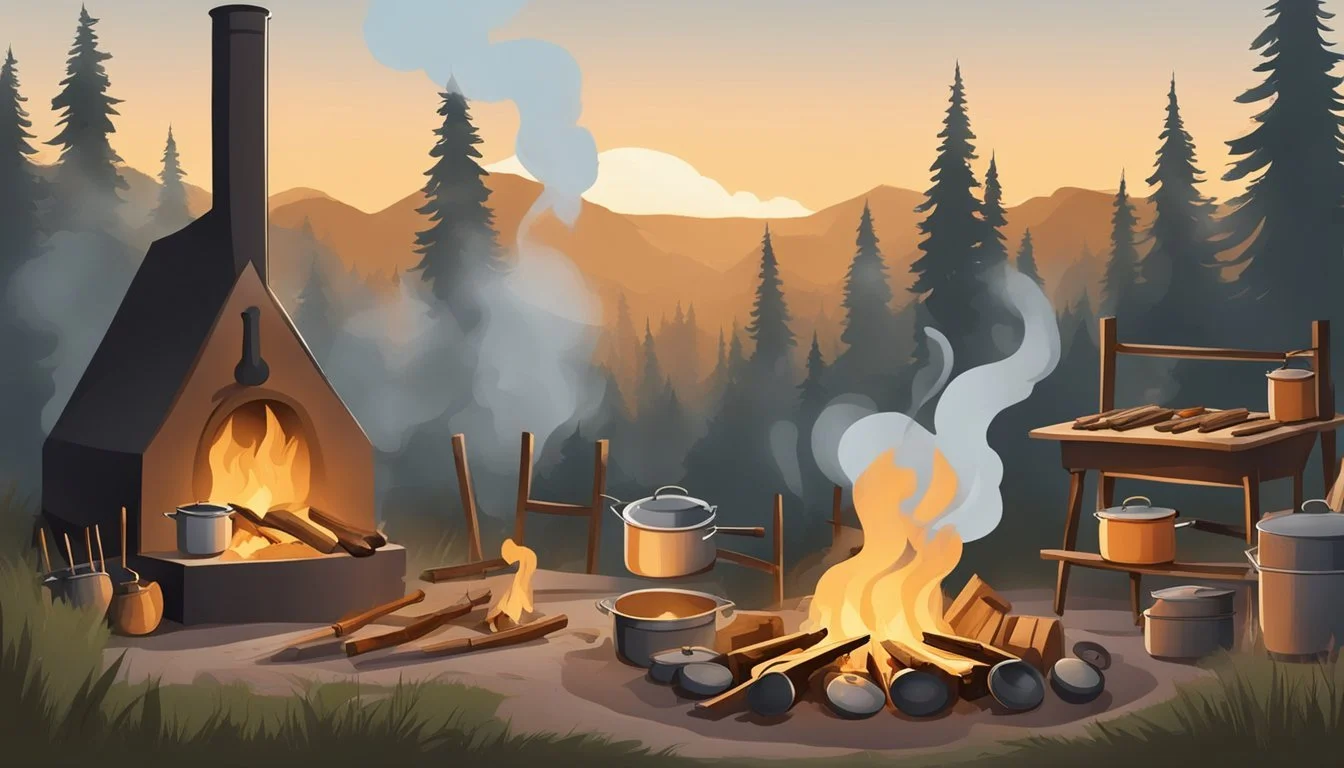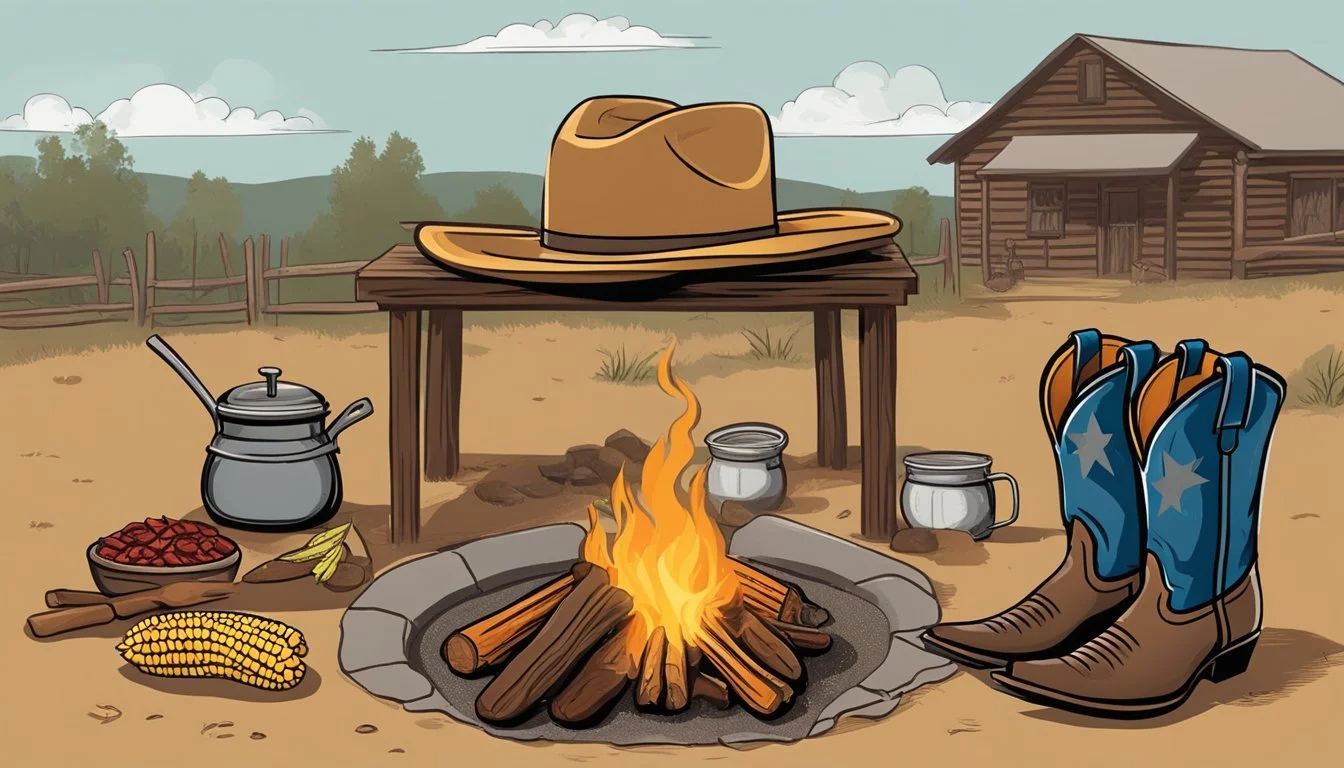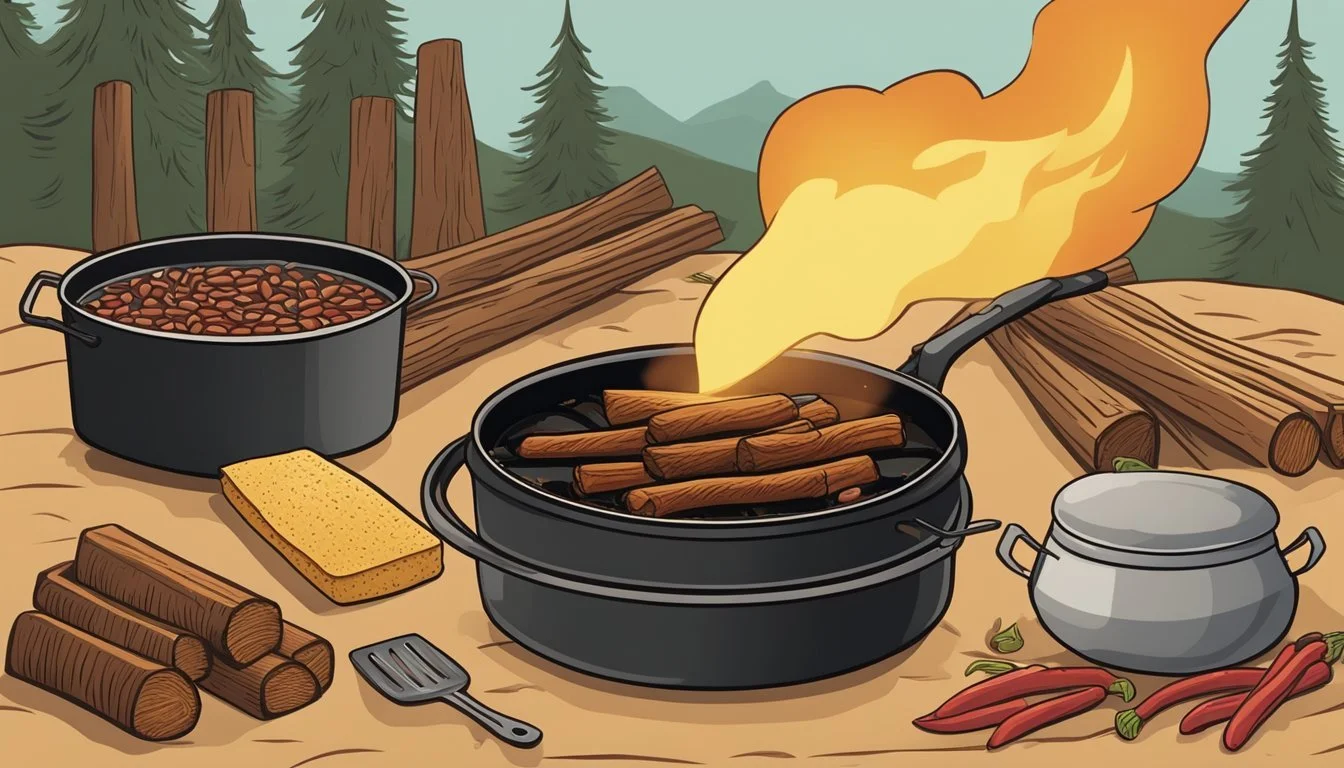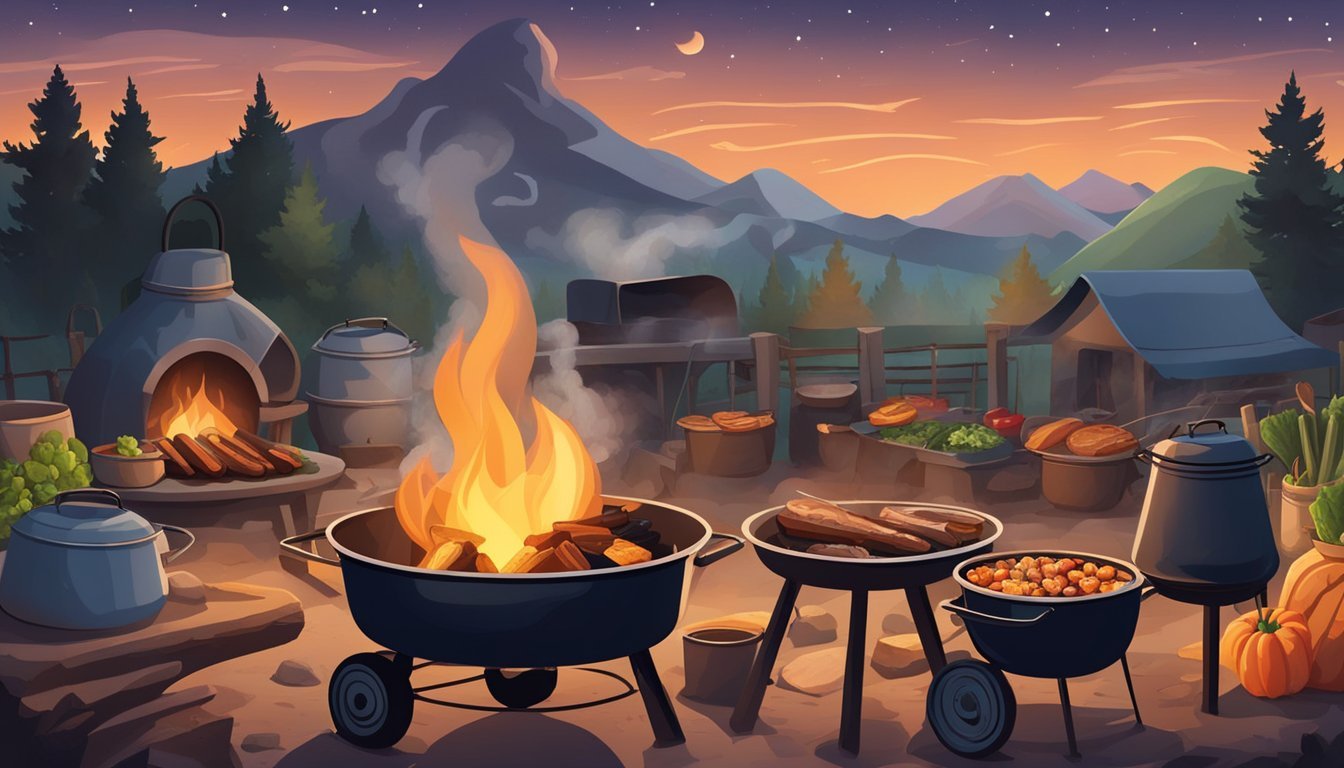The Texas-Style Campfire Cookout
Celebrating a Legacy of Frontier Flavors
The Texas-style campfire cookout is a storied practice deeply embedded in the state's cultural heritage. Reminiscent of chuckwagon days and cowboy fare, this culinary tradition celebrates the simplicity and heartiness of open-fire cooking. The cookout is a communal event where Texans gather around the crackling flames to enjoy dishes that are as robust in flavor as they are in history. With its roots in the trail-driving era, these outdoor feasts spotlight the rustic cooking methods that cowhands used to feed their crews.
Incorporating regional flavors and ingredients, Texas cuisine at these cookouts often includes beef brisket, (What wine goes well with beef brisket?) sausages, and a variety of sides, from pinto beans to spicy chili. The culinary techniques employed resonate with heritage, where cast-iron skillets and Dutch ovens are just as likely to be used as modern grills. Cooking over an open fire imparts a smoky taste that is synonymous with Texas barbecue—one of the many facets of this multi-dimensional state tradition.
As the landscape of Texas cuisine evolves, the campfire cookout remains a testament to the state's ability to honor its past while continuing to innovate. It is a tradition that celebrates community, openness to the outdoors, and the unique flavors that can only be achieved through the time-honored practice of cooking with fire and smoke.
Historical Roots of Texas-Style BBQ
The historical roots of Texas-style barbecue are as rich and varied as the state's famous brisket. They span from the culinary traditions of indigenous tribes to European immigrants, all the way through the gritty life of cowboys on the open range, culminating in Texas becoming a world-renowned barbecue (What wine goes well with barbecue?) capital.
Influence of Indigenous Peoples and European Settlers
The native peoples of Texas used smoking techniques to preserve meat, a practice that contributed to the development of modern barbecue. When European settlers, notably those from Germany and Czechoslovakia, arrived, they brought with them their own meat-smoking traditions. These influences combined and evolved into a unique culinary practice that underpins Texas-style BBQ today.
Culinary Techniques: Smoking over various woods, employing varied spices and rubs.
European Contribution: Inclusion of sausages and technique transfer from meat markets to BBQ.
Evolution from Cowboy Culture to Barbecue Capital
Texas's rise as a barbecue capital is deeply linked to its cowboy culture, a heritage that introduced the open-pit style of cooking beef over a mesquite fire. This cooking style became a staple during cattle drives, laying the foundation for communal cookouts and modern barbecue joints.
Cattle Drives: Pioneered beef as a central BBQ ingredient.
Communal Aspect: Underlined the social gathering aspect of BBQ.
Transforming from necessity to art, these gatherings turned into events where slow-cooked meats became a centerpiece. Today, major cities in Texas such as Houston, Austin, and Dallas take pride in their barbecue, each offering their unique spin on the tradition but always honoring its deep historical roots.
Understanding Texas Barbecue
Texas barbecue is a revered tradition in the Lone Star State, where smoky flavor and tender meats define this beloved aspect of Texan cuisine. From the hardwood smoke to the meticulous cooking techniques, every aspect reflects the state's rich cultural heritage.
Defining Texas-Style BBQ
Texas-style BBQ is characterized by its use of high-quality meats, predominantly beef, which is slow-smoked over various types of wood. Meats such as brisket, sausage, and ribs are central to the tradition, with each cut carefully chosen for its ability to transform under low and slow heat. Barbecue in Texas isn't just cooking; it's a meticulous process that pays homage to the state's ranching history.
Regional Styles: Central, East, South, and West Texas
Central Texas: Known for its German and Czech influences, Central Texas BBQ emphasizes the quality of the meat above all. It typically features a simple rub, allowing the natural flavors to shine, and is smoked over oak for a distinct taste. Sauce is often served on the side, not to overshadow the meat's flavor.
East Texas: The East Texas style is heavily influenced by the Southern BBQ tradition, with meat that's usually marinated in a sweet tomato-based sauce and cooked until it falls off the bone. It’s commonly served chopped rather than sliced, often on a bun.
South Texas: In South Texas, the focus is on barbacoa, which involves traditionally cooking the head of a cow in the ground overnight. The style includes a lot of Mexican flavors, with moist and tender meat often served with fresh tortillas.
West Texas: West Texas barbecue, also known as "cowboy style," involves cooking over direct heat, typically mesquite wood. This method imparts a strong smoky flavor and can be traced back to the cooking methods of early settlers and cowboys in the region.
Key Ingredients and Flavors
In a Texas-style campfire cookout, the confluence of select meats and the distinct woods used for smoking are paramount. Each contributes significantly to the robust flavor profile that defines this culinary tradition.
Meats: Beef Brisket, Pork Ribs, Sausage, and More
Beef Brisket: The cornerstone of Texas BBQ, brisket is prized for its succulent tenderness when slow-cooked over an indirect flame. It absorbs the essence of the smoke, resulting in a deeply savory and slightly tangy taste that's uniquely Texan.
Pork Ribs: (What wine goes well with pork ribs?) Another favorite, pork ribs are known for their rich, smoky flavor. They require a deft touch—smoked to perfection until the meat is juicy and falls off the bone.
Sausage: A staple in Texas BBQ, sausages range from spicy to mild, with each type offering a different flavor profile, but all carry the signature smokiness that barbecue aficionados cherish.
Chicken: Typically smoked until the skin is crispy and the meat is moist, chicken adds variety to the Texas BBQ platter with its lighter yet flavorful profile.
Wood and Smoke: Mesquite, Pecan, and Hickory
Mesquite: This wood imbues meats with a strong, smoky flavor that's almost synonymous with Texas BBQ. It burns hot and fast, ideal for grilling.
Pecan: For a milder, sweeter smoke, pecan is the go-to. It lends a nuanced flavor to meats without overwhelming their natural taste.
Hickory: Offering a robust, bacon-like flavor, hickory is often used in combination with other woods to add layers of smokiness to the meats, creating a complex and hearty finish.
Culinary Techniques
In the Texas-style campfire cookout tradition, two defining techniques elevate the flavors of meats: the meticulous process of smoking and the artful application of dry rubs and sauces.
Smoking Meats: The Low and Slow Method
The hallmark of Texas-style BBQ is the technique of smoking meats, where patience is key. Smoking refers to cooking meat at low temperatures, typically between 225-275°F, over a prolonged period. This "low and slow" method allows the meat to absorb the smoky flavors (What wine goes well with smoky flavors?) and become tender. Hardwoods such as hickory, oak, mesquite, or pecan are carefully selected for their smoke, which imparts distinct flavors integral to Texas BBQ.
Dry Rubs and BBQ Sauces
In Texas BBQ, the use of dry rubs and sauces enhances the meat's flavor profile. Dry rubs are combinations of spices and seasonings applied to the meat before smoking:
Dry Rub Components (Example):
Salt and black pepper (essential base)
Paprika (for color and sweetness)
Garlic powder, onion powder, cayenne pepper (for complexity)
After smoking, meat is often mopped or glazed with BBQ sauce, which introduces a balance of sweetness, tanginess, and spice. While sauce recipes vary, a traditional Texas-style BBQ sauce includes ingredients like tomatoes, vinegar, and spices, and it is known for its bold and savory character.
Staple Dishes and Sides
In any Texas-style campfire cookout, the ensemble of hearty meats and complementary sides forms the bedrock of the tradition, delivering a flavorful experience rooted in local culinary customs.
Classic BBQ Dishes: Ribs, Brisket, and Chicken
In the heart of a Texas cookout, one will find the smoky and succulent flavors of beef brisket, pork ribs, and chicken. The brisket, typically rubbed with spices and cooked low-and-slow over indirect heat, boasts a tender and juicy texture. Pork ribs, glazed with a sticky barbecue sauce, are renowned for their fall-off-the-bone meat. Lastly, the chicken is often marinated in a rich blend of seasonings then grilled to perfection, balancing crisp skin with moist flesh.
Beef Brisket: Slow-cooked, with a smoky bark and tender interior.
Pork Ribs: Coated in BBQ sauce, tender, and flavorsome.
BBQ Chicken: Marinated and perfectly charred for a juicy bite.
Tex-Mex Favorites: Tacos, Enchiladas, and Fajitas
No Texas cookout would be complete without incorporating elements of Tex-Mex cuisine. Guests often relish in the spiced meats and fresh accoutrements of tacos, the savory fillings and chili sauce-covered enchiladas, and the sizzling fajitas with their grilled onions and peppers. Each dish offers a nuanced blend of Mexican tradition and Texas twang.
Tacos: Stuffed with seasoned meats and garnished with fresh toppings.
Enchiladas: Rolled tortillas filled with meat or cheese, coated in a chili sauce.
Fajitas: Grilled strips of meat served with sautéed onions and bell peppers.
Traditional Sides: Beans, Slaw, and Potato Salad
Sides are pivotal to rounding out the flavors of a Texas BBQ. Traditional sides commonly include beans—often pinto beans stewed with spices and chunks of pork, a tangy and creamy slaw prepared with mayonnaise, vinegar, and a hint of sweetness, and the classic potato salad, a blend of potatoes in a dressing of mayonnaise or mustard, flavored with pickles, onions, and herbs.
Beans: Pinto beans cooked with pork and a blend of spices.
Slaw: Creamy, with a balance of tanginess and sweetness.
Potato Salad: Creamy or tangy dressing, with added textures from pickles and onions.
Serving and Presentation
In Texas-style campfire cookouts, serving and presentation are integral to the dining experience, enhancing the flavors and embodying the tradition of the culinary practice.
The Importance of Plating and Atmosphere
The presentation of the menu items is crafted to complement the rugged, outdoor essence of a campfire cookout. Chefs focus on simple yet impactful plating techniques that honor the food's rustic origins. Plates are often composed with a nod to the heritage of Texan barbecue, allowing the grilled or smoked meats (What wine goes well with smoked meats?) to take center stage. Atmosphere plays a crucial role as the natural setting, often under the stars around a flickering campfire, provides an authentic backdrop that imbues the meal with a sense of tradition and place.
Pairing with Condiments, Bread, and Pickles
Plating is typically accompanied by the customary sides that complete the Texas campfire dining experience:
Condiments: A selective array of condiments such as barbecue sauce or a spicy Texas-style salsa allows guests to tailor the flavor to their liking.
White Bread: Often served in a basket, simple slices of white bread are provided for sopping up juices and sauces.
Pickles: A staple at any Texas cookout, pickles offer a zesty contrast to the rich flavors of smoked meats.
Side Item Purpose White Bread Absorbs flavors, offers a neutral taste palate. Pickles Adds acidity and crunch, balancing the savory notes. Condiments Enhances and personalizes the taste of the meats.
Each of these components contributes to the full sensory experience of a Texas-style campfire cookout. The combination of well-presented dishes, suitable pairings, and an inviting outdoor atmosphere allows the culinary tradition to be savored to its fullest.
Culinary Variations and Influences
Texas campfire cookouts reflect a melting pot of cultures, each bringing distinct flavors and cooking techniques to the table. The cuisine is characterized by a robust amalgamation of Tex-Mex and Cajun influences, and a modern take that includes barbeque adaptations and vegetarian options.
Fusion with Mexican and Cajun Cuisine
Tex-Mex cuisine dominates the campfire scene with dishes that blend Texas fare with Mexican flavors. Nopales (cactus paddles) often feature in these meals, introducing a crisp and tart aspect to stews and salads. Similarly, Cajun cuisine contributes to the culinary tapestry with its rustic, spice-laden dishes such as jambalaya and gumbo, influenced by Louisiana's Cajun community.
Tex-Mex staples:
Tacos with various fillings
Grilled nopales
Enchiladas with chili con carne
Cajun specialties:
Andouille sausage
Blackened fish
Seafood boil
Contemporary Texas BBQ and Vegetarian Options
Barbeque is intrinsic to Texas cookouts, evolving continuously to embrace new tastes. Central Texas-style smoked brisket and East Texas barbeque with spicy tomato-based sauces typify regional distinctions. Meanwhile, a growing demand from vegetarians has spurred the inclusion of plant-based alternatives. These options ensure that traditional cookouts can be enjoyed by all, regardless of dietary preferences.
Barbeque variations:
Smoked brisket
Spicy pork ribs
Tomato-based barbeque sauce varieties
Vegetarian alternatives:
Smoked portobello mushrooms
Grilled vegetable skewers
Barbecue Culture and Community
In Texas, barbecue is not just a cooking method; it's a gathering force that unites communities with music, storytelling, and a deep sense of pride. This cooking tradition goes beyond the food, embedding itself into the very fabric of Texan society, influencing its lifestyle and cultural expressions.
Music, Storytelling, and Gatherings
At the heart of every Texas barbecue is the assembly of individuals around fire, smoke, and savory aromas. These occasions naturally foster a convivial atmosphere where music and storytelling are as essential as the brisket and ribs on the plate. From blues to country, live bands often set the scene, their melodies interweaving with the chatter of friends and families. Storytelling, an age-old form of entertainment and education in Texas, thrives in these settings. These narratives, passed down through generations, reinforce community bonds and preserve the state's rich history.
Texas BBQ as a Lifestyle and Source of Pride
Texas barbecue has evolved into a lifestyle for many Texans, symbolizing a commitment to the time and effort required to smoke meats to perfection. This lifestyle is marked by a profound pride, where pitmasters and enthusiasts alike see their barbecue skills as a representation of state identity. BBQ joints, from rural roadside stands to urban eateries, serve as hubs for community interaction and culinary appreciation. They are places where personal achievements in mastering the craft are celebrated and where the uninitiated are welcomed to partake in this celebrated tradition.
Barbecue Education and Resources
Texas-style barbecue is more than just a method; it's a craft that requires guidance, practice, and an understanding of traditions. This section provides resources for those looking to immerse themselves in the world of Texas barbecue, from novices seeking foundational education to enthusiasts searching for festivals and literature on the subject.
For Beginners: Tips and Tricks
Barbecue novices need not be overwhelmed by the complexities of Texas-style barbecuing. They can start by learning how to maintain consistent low temperatures and the importance of "low and slow" cooking, which is indispensable for the infusion of smoke and to achieve tender meat. Resources such as Texas Monthly often feature articles with beginner tips and insightful techniques.
Start with simpler cuts of meat.
Learn to maintain a consistent temperature.
Don't rush the process — patience is essential.
Notable BBQ Joints and Festivals
For those seeking a taste of authentic Texas barbecue and a peek into its vibrant culture, visiting renowned BBQ joints and festivals is a must. Establishments like Franklin Barbecue have set a high standard in barbecue excellence and serve as educational experiences in themselves. Festivals present a ripe opportunity for learning and tasting, as pitmasters gladly share their passion and knowledge with attendees.
Notable BBQ Joints:
Franklin Barbecue
Smitty's Market
Louie Mueller Barbecue
Celebrated Festivals:
Austin BBQ Throwdown
Texas Monthly BBQ Fest
The Red Dirt BBQ & Music Festival
Cookbooks and Guides: Franklin Barbecue, The Big Texas Cookbook
Literature can be a pitmaster's best friend, providing detailed recipes, history, and insider secrets. "Franklin Barbecue: A Meat-Smoking Manifesto" by Aaron Franklin offers a comprehensive guide, from managing fire to smoking techniques. "The Big Texas Cookbook" is another key resource that compiles recipes and stories from across the state to showcase regional variations and traditions.
Franklin Barbecue: A Meat-Smoking Manifesto
The Big Texas Cookbook
Articles in Texas Monthly on barbecuing trends and local pitmasters






